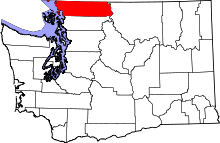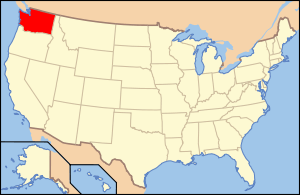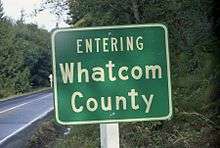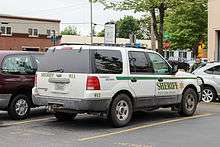Whatcom County, Washington
| Whatcom County, Washington | ||
|---|---|---|
| ||
 Location in the state of Washington | ||
 Washington's location in the U.S. | ||
| Founded | March 9, 1854 | |
| Seat | Bellingham | |
| Largest city | Bellingham | |
| Area | ||
| • Total | 2,503 sq mi (6,483 km2) | |
| • Land | 2,107 sq mi (5,457 km2) | |
| • Water | 397 sq mi (1,028 km2), 16% | |
| Population (est.) | ||
| • (2014) | 208,351 | |
| • Density | 99/sq mi (38/km²) | |
| Congressional districts | 1st, 2nd | |
| Time zone | Pacific: UTC-8/-7 | |
| Website |
www | |


Whatcom County /ˈhwɒtkəm/ is a county located in the U.S. state of Washington. As of the 2010 census, the population was 201,140.[1] The county seat and largest city is Bellingham.[2] The county was created out of Island County by the Washington Territorial Legislature on March 9, 1854, and originally included present day San Juan and Skagit Counties.[3] Its name ultimately derives from the Lummi word Xwotʼqom, meaning "noisy water."[4][5]
Whatcom County comprises the Bellingham, WA Metropolitan Statistical Area.
Whatcom County's northern border is the international boundary with the Canadian province of British Columbia; adjoining the county on the north are four of metropolitan Vancouver's suburbs, Delta, White Rock, Surrey, Langley, and, in the central Fraser Valley, Abbotsford, with several shopping malls and other services in Bellingham and elsewhere in the county geared to cross-border shopping and recreation. The five crossing points are two at Blaine (one at the Peace Arch, located on the Interstate 5 crossing, and the other a commercial and passenger crossing on the Pacific Highway at State Route 543, both to Surrey, British Columbia), as well as at Lynden (SR 539, to Aldergrove), Sumas (SR 9, to Abbotsford), and Point Roberts (Tyee Drive, to Tsawwassen).
Geography
According to the U.S. Census Bureau, the county has a total area of 2,503 square miles (6,480 km2), of which 2,107 square miles (5,460 km2) is land and 397 square miles (1,030 km2) (16%) is water.[6]
The county includes Lake Whatcom, which empties into Bellingham Bay by way of Whatcom Creek. Physiographically, Whatcom County is an extension of the Fraser Valley or "Lower Mainland" area of British Columbia, which is essentially the lowland delta plain of the Fraser River - at some times in the past one of the Fraser River's lower arms entered Bellingham Bay near Bellingham via what is now the mouth of the Nooksack River. A very small part of the county, Point Roberts, about 5 square miles (13 km2), is an extension of the Tsawwassen Peninsula, which is bisected by the international boundary along the 49th Parallel. The highest point in the county is the peak of the active volcano Mount Baker at 10,778 feet (3,285 m) above sea level. The lowest points are at sea level along the Pacific Ocean.
Geographic features
- Bellingham Bay
- Birch Bay
- Cascade Mountains
- Chuckanut Mountains
- Mount Baker, highest point in Whatcom County
- American Border Peak
- Sumas Mountain
- Mount Shuksan
- Chilliwack River/Chilliwack Lake
- Eliza Island
- Lake Whatcom
- Lummi Island
- Lummi Bay
- Nooksack River
- North Lookout Mountain, known locally as Galbraith Mountain
- Portage Island
- Semiahmoo Bay
- Skagit River/Ross Lake
- Sumas River
National protected areas
- Mount Baker National Recreation Area
- Mount Baker-Snoqualmie National Forest (part)
- North Cascades National Park (part)
- Ross Lake National Recreation Area (part)
- Pacific Northwest National Scenic Trail (part)
State protected areas
- Birch Bay State Park
- Lake Terrell Wildlife Refuge
- Larrabee State Park
- Lookout Mountain (DNR)
- Lummi Island (part) (DNR)
- Stewart Mountain (DNR)
- Lake Whatcom Watershed
Major highways
- Interstate 5 connecting with Seattle, Portland, Sacramento, Los Angeles, San Diego and points south.
- SR 20 connecting US 101 and Sidney, British Columbia with Newport, Washington via the North Cascades Highway. Farthest north highway thru the Cascade Mountains in USA. Note that this highway does not connect to most of Whatcom County - Instead, a person would have to travel south to Sedro-Woolley in Skagit County to connect to Highway 20.
- Alaska Marine Highway connecting Alaska highways to the Interstate Highway System.
Adjacent counties
- Okanogan County - east
- Skagit County - south
- San Juan County - southwest
- Metro Vancouver - north
- Fraser Valley Regional District, British Columbia - north
- Capital Regional District, British Columbia - west
Demographics
| Historical population | |||
|---|---|---|---|
| Census | Pop. | %± | |
| 1860 | 352 | — | |
| 1870 | 534 | 51.7% | |
| 1880 | 3,137 | 487.5% | |
| 1890 | 18,591 | 492.6% | |
| 1900 | 24,116 | 29.7% | |
| 1910 | 49,511 | 105.3% | |
| 1920 | 50,600 | 2.2% | |
| 1930 | 59,128 | 16.9% | |
| 1940 | 60,355 | 2.1% | |
| 1950 | 66,733 | 10.6% | |
| 1960 | 70,317 | 5.4% | |
| 1970 | 81,950 | 16.5% | |
| 1980 | 106,701 | 30.2% | |
| 1990 | 127,780 | 19.8% | |
| 2000 | 166,814 | 30.5% | |
| 2010 | 201,140 | 20.6% | |
| Est. 2014 | 208,351 | [7] | 3.6% |
| U.S. Decennial Census[8] 1790–1960[9] 1900–1990[10] 1990–2000[11] 2010–2014[1] | |||
As of the census[12] of 2000, there were 166,814 people, 64,446 households, and 41,116 families residing in the county. The population density was 79 people per square mile (30/km²). There were 73,893 housing units at an average density of 35 per square mile (13/km²). The racial makeup of the county was 88.41% White, 0.69% Black or African American, 2.82% Native American, 2.78% Asian, 0.14% Pacific Islander, 2.49% from other races, and 2.66% from two or more races. 5.21% of the population were Hispanic or Latino of any race. 15.5% were of German, 9.2% English, 8.2% Dutch, 7.9% Irish, 7.0% Norwegian and 6.6% United States or American ancestry.
There were 64,446 households out of which 30.40% had children under the age of 18 living with them, 51.20% were married couples living together, 8.80% had a female householder with no husband present, and 36.20% were non-families. 25.60% of all households were made up of individuals and 8.40% had someone living alone who was 65 years of age or older. The average household size was 2.51 and the average family size was 3.03.
In the county, the population was spread out with 24.10% under the age of 18, 14.20% from 18 to 24, 27.50% from 25 to 44, 22.50% from 45 to 64, and 11.60% who were 65 years of age or older. The median age was 34 years. For every 100 females there were 97.10 males. For every 100 females age 18 and over, there were 95.00 males.
The median income for a household in the county was $40,005, and the median income for a family was $49,325. Males had a median income of $37,589 versus $26,193 for females. The per capita income for the county was $20,025. About 7.80% of families and 14.20% of the population were below the poverty line, including 14.20% of those under age 18 and 8.30% of those age 65 or over.
Government
The Whatcom County government is a municipal corporation operating under a County Charter. Voters approved the County Charter in 1978. The Charter acts as a county constitution. Whatcom County is one of only four counties in Washington to use the home rule charter provision of state law.[13] Local government is split between the county, incorporated cities and towns, and special purpose districts. These local governments are established and operate according to state law. These local governments operate independently from the county government.
County government
The Charter establishes the structure of Whatcom County government. The County Council holds legislative powers granted to counties. The council consists of seven members elected for a term of four (4) years. Council members are elected at the general election in November of odd-numbered years. Three council members are elected one year before a Presidential election; four council members are elected one year after a Presidential election. Two members are elected from each of three districts; the seventh member is an at-large member.[14] The County Council also serves as the county board of health.[14]
The executive branch consists of six elected officials, a County Executive and five department heads. The County Executive is similar to a mayor or governor. The Assessor, Auditor, Prosecuting Attorney, Sheriff, and Treasurer are elected independently from the County Executive and serve as department heads. These six officials serve four year terms.[15][16] The county council establishes various departments by ordinance. The county council or county executive appoint department heads. These departments include administrative services, health, medical examiner, planning and development services, parks and recreation, and public works.[17]
The judicial branch consists of a district court and superior court. The district court is a court of limited jurisdiction. The district court handles civil and criminal cases. Criminal cases are limited to adults charged with misdemeanor and/or gross misdemeanor offenses. State law specifies what cases are in the district court's jurisdiction. The district court operates a small claims court to resolve civil cases involving monetary damages not exceeding $5,000. No attorneys are permitted to appear in small claims court. Cases are heard using less formal procedures.[18] The district court has two judges, a court commissioner, and a support staff. The superior court is a court of general jurisdiction.[15][18] Superior court hears civil cases exceeding $75,000 or requesting nonmonetary remedies.[19] Superior court hears all juvenile criminal cases and all adult felony cases. Superior court also hears appeals from district court and municipal courts.[19] Superior court staff include three judges, three full-time court commissioners, two part-time court commissioners, and support staff. District and superior court judges are elected by the county voters for a term of four (4) years. Court commissioners are appointed by and serve at the discretion of elected judges; commissioners have powers and responsibilities equal to elected judges.
Cities and towns
Incorporated cities and towns provide municipal services. Each city or town has an elected council and mayor. Common cities known in Whatcom County are Bellingham, Blaine and Ferndale.
Special purpose districts
Special purpose districts include cemetery, fire, hospital, library, school, and water and sewer districts. Each special district is governed by officials elected by voters within that jurisdiction.
Fire districts
There are 11 fire districts, 2 city fire departments and 1 regional fire authority providing fire prevention, fire fighting, and emergency medical services. Each fire district is governed by an elected board of commissioners. Most districts have three commissioners. Fire districts receive most of their revenue from property taxes. All of the fire districts and the regional fire authority have volunteer or paid-call firefighters and emergency medical technicians (EMTs), as does the City of Lynden Fire Department. The City of Bellingham is an all-career department. Some of the districts also have full-time firefighter/EMTs. All fire districts use 9-1-1 for emergency calls. Whatcom County has one 9-1-1 call center located in Bellingham. Fire/EMS calls are processed and dispatched at a second PSAP (Public Safety Answering Point) called Prospect that is located at a fire station in Bellingham. Additional dispatching locations provide backup capacity to answer emergency calls.
Whatcom County Fire Districts are:[20]
- Fire District 1 serves Deming, Everson, Nooksack, and Nugents Corner.
- Fire District 5 serves Point Roberts.
- Fire District 7 serves areas near Ferndale and Cherry Point.
- Fire District 8 serves Bellingham International Airport, the Lummi Nation, and Marietta.
- Fire District 11 serves Lummi Island Lummi Island
- Fire District 14 serves areas around SR 542 between Deming and Maple Falls, Washington, SR 547, and Sumas.
- Fire District 16 serves communities along SR 9 south of SR 542.
- Fire District 17 serves Sandy Point.
- Fire District 18 serves southern Lake Whatcom and Glenhaven Lakes.
- Fire District 19 serves Glacier.
- Fire District 21 (North Whatcom Fire Rescue) serves northwest Whatcom County including Birch Bay, Blaine, Laurel, and Lynden°.
° outside Lynden city limits only. Also, the district contrcts for service s with Fire Dist 4. The Lynden Fire Department serves Lynden.
- The South Whatcom Regional Fire Authority serves Geneva, Sudden Valley, Chuckanut Drive, Lake Samish and Yew Street Road.
Economy
Whatcom County is the top producer of raspberries in the state. According to the Seattle Times, in 2004 Whatcom County growers produced 46 million pounds of raspberries, 85% of the state's crop. Given that the state itself is the #1 producer of raspberries in the country, with over 87.8% of the crop in 2002, this makes Whatcom County responsible for almost 75% of the nation's raspberry production.
Education
Primary and Secondary Education
Whatcom County residents are served by a number of public and private schools. These schools provide preschool, primary (K-5), and secondary (6-12) education. Public schools are operated by eight school districts. Each school district is an independent local government managed by an elected school board. Seven districts serve the western portion of Whatcom County.[21] One district serves the southeast corner of Whatcom County. The remaining portion of the county is national forest or national park land, which has no permanent residents.
These districts are:
- Bellingham School District serves Bellingham, Chuckanut, Lake Samish, and Sudden Valley.
- Blaine School District serves Blaine, Birch Bay, and Point Roberts.
- Concrete School District serves the county's southeast corner including Newhalem and Diablo.
- Ferndale School District serves Ferndale, Custer, Lummi Island, and the Lummi Nation.
- Lynden School District serves Lynden and surrounding areas.
- Meridian School District serves rural communities between Bellingham and Lynden.
- Mount Baker School District serves communities along the Mount Baker Highway and Nooksack River.
- Nooksack Valley School District serves Everson, Nooksack, and Sumas.
Numerous private schools operate in Whatcom County including Assumption Catholic School, St. Paul's Academy, Lynden Christian Schools, Bellingham Christian Schools, and the Waldorf School.
Higher education
Whatcom County hosts five institutions of higher education. Western Washington University (Western) is the third largest public university in Washington. Western offers bachelor's and master's degrees through seven colleges. Western enrolls over 15,000 students. Whatcom Community College is a public community college offering academic certificate programs and associate degrees. Two universities and two colleges are located in Bellingham. One college is located on the Lummi Nation (Lummi Reservation) west of Bellingham. Bellingham Technical College is a public technical and vocational college located in Bellingham. Trinity Western University (TWU) is a private, Christian university based in Langley, BC about 25 miles north of Bellingham. TWU operates a branch campus in Bellingham offering undergraduate courses and supports TWU's bachelor's degree completion program.
Northwest Indian College is a college supported by the Lummi Nation and serves the Native American community. Northwest Indian College is located on the Lummi Nation (Lummi Reservation) about five miles west of Bellingham.
Communities
Cities
Census-designated places
Unincorporated communities
Ghost town
Notable people
- Steve Alvord, defensive tackle in the NFL in 1987-88.
- Ryan Stiles – Emmy Award-nominated actor and comedian.
- Hilary Swank – multiple Academy Award-winning actress.
See also
- National Register of Historic Places listings in Whatcom County, Washington
- Nooksack Salmon Enhancement Association
References
- 1 2 "State & County QuickFacts". United States Census Bureau. Retrieved January 8, 2014.
- ↑ "Find a County". National Association of Counties. Retrieved 2011-06-07.
- ↑ "Milestones for Washington State History — Part 2: 1851 to 1900". HistoryLink.org. March 6, 2003.
- ↑ Oakley, Janet (July 31, 2005). "Whatcom County — Thumbnail History". HistoryLink.org.
- ↑ Johnson, Annie (2004). "Shifting Shorelines".
- ↑ "2010 Census Gazetteer Files". United States Census Bureau. August 22, 2012. Retrieved July 16, 2015.
- ↑ "Annual Estimates of the Resident Population for Incorporated Places: April 1, 2010 to July 1, 2014". Retrieved June 4, 2015.
- ↑ "U.S. Decennial Census". United States Census Bureau. Retrieved January 8, 2014.
- ↑ "Historical Census Browser". University of Virginia Library. Retrieved January 8, 2014.
- ↑ "Population of Counties by Decennial Census: 1900 to 1990". United States Census Bureau. Retrieved January 8, 2014.
- ↑ "Census 2000 PHC-T-4. Ranking Tables for Counties: 1990 and 2000" (PDF). United States Census Bureau. Retrieved January 8, 2014.
- ↑ "American FactFinder". United States Census Bureau. Retrieved 2011-05-14.
- ↑ Whatcom County History
- 1 2 Whatcom County Council
- 1 2 County Elected Officials
- ↑ County Code and Charter
- ↑ Whatcom County Departments
- 1 2 Whatcom County District Court
- 1 2 Whatcom County Superior Court
- ↑ Whatcom County Fire Districts map
- ↑ School Districts in Whatcom County
External links
Coordinates: 48°50′N 121°54′W / 48.83°N 121.90°W
 |
Metro Vancouver, British Columbia, Canada; and Fraser Valley Regional District, British Columbia, Canada |  | ||
| Strait of Georgia | |
Okanogan County | ||
| ||||
| | ||||
| San Juan County | Skagit County |
| |||||||||||||||||||||||||||||
